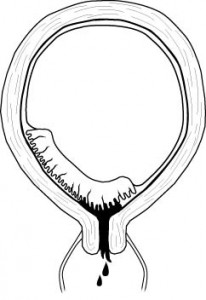Normally, the placenta is attached to the uterus in an area remote from the cervix.
Sometimes, the placenta is located in such a way that it covers the cervix. This is called a placenta previa.
There are degrees of placenta previa:
- A complete placenta previa means the entire cervix is covered. This positioning makes it impossible for the fetus to pass through the birth canal without causing maternal hemorrhage. This situation can only be resolved through cesarean section.
- A marginal placenta previa means that only the margin or edge of the placenta is covering the cervix. In this condition, it may be possible to achieve a vaginal delivery if the maternal bleeding is not too great and the fetal head exerts enough pressure on the placenta to push it out of the way and tamponade bleeding which may occur.

Clinically, these patients present after 20 weeks with painless vaginal bleeding, usually mild. This is in contrast to patients with placental abruption, who usually experience significant pain and contractions. An old rule of thumb is that the first bleed from a placenta previa is not very heavy. For this reason, the first bleed is sometimes called a “sentinel bleed.”
Later episodes of bleeding can be very substantial and very dangerous. This can lead to hypovolemic shock and maternal death. Because a pelvic exam may provoke further bleeding it is important to avoid a vaginal or rectal examination in pregnant women during the second half of their pregnancy unless you are certain there is no placenta previa.
Factors associated with an increased risk of placenta previa include:
- High maternal parity
- Increased maternal age
- Previous cesarean section
- Previous uterine surgery
- Uterine malformations
- Use of cocaine or its derivatives
- Cigarette smoking
- Ascherman’s syndrome
- Large numbers of D&Cs
The location of the placenta is best established by ultrasound. If ultrasound is not available, one reliable clinical method of ruling out placenta previa is to check for fetal head engagement just above the pubic symphysis.
Using a thumb and forefinger and gently pressing into the maternal abdomen, the fetal head can be palpated. If the fetal head is deeply engaged in the pelvis, it is basically impossible for a placenta previa to be present because there is not enough room in the birth canal for both the fetal head and a placenta previa. Be gentle with this exam, since your thumb and forefinger might be pressing directly on an anterior placenta previa.
An x-ray of the pelvis (pelvimetry) can likewise rule out a placenta previa, but only if the fetal head is deeply engaged. Otherwise, an x-ray will usually not show the location of the placenta.
Both CT and MRI will reveal a placenta prevue, but ultrasound is generally preferred because of its’ safety, availability, speed and accuracy with dynamic positioning.
